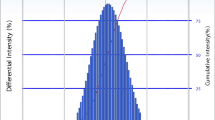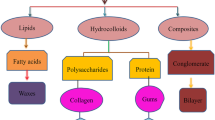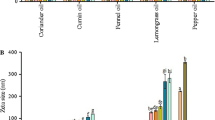Abstract
Nanoemulsions exhibit a number of advantages to carry and deliver lipophilic compounds such as essential oils (EOs) due to their good stability and high surface area per volume unit. The purpose of this work was to assess the long-term stability of nanoemulsions of clove and lemongrass (LG) EOs and their principal components eugenol and citral (CI), respectively, at 3 different concentrations (2, 5 or 10 times their respective minimum inhibitory concentrations) and at two storage temperatures (1 °C and 21 °C). The initial droplet size of LG and CI-loaded nanoemulsions was below 100 nm and most of them kept droplet sizes in the nano-range until the end of storage at both temperatures. The ζ-potential was lower than − 40 mV, but it increased through storage, indicating a weaker alginate adsorption at the oil surface at both temperatures. The antimicrobial activity increased with the EOs concentration and was negatively affected by the highest storage temperature. Nanoemulsions containing CI and LG were able to significantly decrease Escherichia coli counts during storage, particularly at 1 °C. Nanoemulsions containing 1.0 and 2.0% w/w CI and 2.5% w/w LG were the most efficient in reducing Botrytis cinerea growth through storage, mainly at 1 °C. The nanoemulsions containing 1.0 and 2.0% w/w CI, as well as, 1.25 and 2.5% w/w LG better maintained their stability and antimicrobial effect along 6-months storage mainly when at 1 °C, making those nanoemulsions suitable as edible coatings for food preservation. Future studies should be oriented to evaluate the impact of these nanoemulsions on the organoleptic properties of coated foods and their potential toxicity.



Similar content being viewed by others
References
Abd-Elsalam KA, Khokhlov AR (2015) Eugenol oil nanoemulsion: antifungal activity against Fusarium oxysporum f. sp. vasinfectum and phytotoxicity on cottonseeds. Appl Nanosci 5:255–265
Aguilar-González AE, Palou E, López-Malo A (2015) Antifungal activity of essential oils of clove (Syzygium aromaticum) and/or mustard (Brassica nigra) in vapor phase against gray mold (Botrytis cinerea) in strawberries. Innov Food Sci Emerg Technol 32:181–185
Apolónio J, Faleiro ML, Miguel MG, Neto L (2014) No induction of antimicrobial resistance in Staphylococcus aureus and Listeria monocytogenes during continuous exposure to eugenol and citral. FEMS Microbiol Lett 354:92–101
Artiga-Artigas M, Acevedo-Fani A, Martín-Belloso O (2017) Effect of sodium alginate incorporation procedure on the physicochemical properties of nanoemulsions. Food Hydrocoll 70:191–200
Artiga-Artigas M, Guerra-Rosas MI, Morales-Castro J et al (2018) Influence of essential oils and pectin on nanoemulsion formulation: a ternary phase experimental approach. Food Hydrocoll 81:209–219
Balouiri M, Sadiki M, Ibnsouda SK (2016) Methods for in vitro evaluating antimicrobial activity: a review. J Pharm Anal 6:71–79
Bonferoni MC, Sandri G, Rossi S et al (2017) A novel ionic amphiphilic chitosan derivative as a stabilizer of nanoemulsions: improvement of antimicrobial activity of Cymbopogon citratus essential oil. Colloids Surf B Biointerfaces 152:385–392
Camele L, Altieri L, DeMartino L et al (2012) In vitro control of post harvest fruit rot fungi by some plant essential oil components. J Mol Sci 13:2290–2300
Chekabab SM, Paquin-Veillette J, Dozois CM, Harel J (2013) The ecological habitat and transmission of Escherichia coli O157:H7. FEMS Microbiol Lett 341:1–12
Faleiro L, Miguel G, Gomes S et al (2005) Antibacterial and antioxidant activities of essential oils isolated from Thymbra capitata L. (Cav.) and Origanum vulgare L. J Agric Food Chem 53:8162–8168
Fernandes J, Gattass CR (2009) Topological polar surface area defines substrate transport by multidrug resistance associated protein 1 (MRP1/ABCC1). J Med Chem 1:1–5
Ferreira JP, Alves D, Neves O et al (2010) Effects of the components of two antimicrobial emulsions on food-borne pathogens. Food Control 21:227–230
Guerra-Rosas MI, Morales-Castro J, Ochoa-Martínez LA et al (2016) Long-term stability of food-grade nanoemulsions from high methoxyl pectin containing essential oils. Food Hydrocoll 52:438–446
Guerreiro AC, Gago CML, Faleiro ML et al (2015) The effect of alginate-based edible coatings enriched with essential oils constituents on Arbutus unedo L. fresh fruit storage. Postharvest Biol Technol 100:226–233. https://doi.org/10.1016/j.postharvbio.2014.09.002
Gupta A, Eral HB, Hatton TA, Doyle PS (2016) Nanoemulsions: formation, properties and applications. Soft Matter 12:2826–2841. https://doi.org/10.1039/c5sm02958a
Hakkı Alma M, Murat Ertaş SN, Kollmannsbergerb H (2007) Chemical composition and content of essential oil from the bud of cultivated Turkish clove. BioResources 2:265–269
Hemaiswarya S, Doble M (2009) Synergistic interaction of eugenol with antibiotics against gram negative bacteria. Phytomedicine 16:997–1005
Hu Q, Gerhard H, Upadhyaya I et al (2016) Antimicrobial eugenol nanoemulsion prepared by gum arabic and lecithin and evaluation of drying technologies. Int J Biol Macromol 87:130–140
Ma Q, Davidson PM, Zhong Q (2016) Antimicrobial properties of microemulsions formulated with essential oils, soybean oil, and Tween 80. Int J Food Microbiol 226:20–25
Majeed H, Liu F, Hategekimana J et al (2016) Bactericidal action mechanism of negatively charged food grade clove oil nanoemulsions. Food Chem 197:75–83
McClements DJ (2002) Colloidal basis of emulsion color. Curr Opin Colloid Interface Sci 7:451–455
McClements DJ (2005) Food emulsions: principles, practices, and thecniques, vol 2. CRC Press, Boca Raton
McClements DJ, Henson L, Popplewell LM et al (2012) Inhibition of Ostwald ripening in model beverage emulsions by addition of poorly water soluble triglyceride oils. J Food Sci 77:33–38
Mohamed Hanaa AR, Sallam YI, El-Leithy AS, Aly SE (2012) Lemongrass (Cymbopogon citratus) essential oil as affected by drying methods. Ann Agric Sci 57:113–116
Naik MI, Fomda BA, Jaykumar E, Bhat JA (2010) Antibacterial activity of lemongrass (Cymbopogon citratus) oil against some selected pathogenic bacterias. Asian Pac J Trop Med 3:535–538
Qian C, McClements DJ (2011) Formation of nanoemulsions stabilized by model food-grade emulsifiers using high-pressure homogenization: factors affecting particle size. Food Hydrocoll 25:1000–1008
Rodríguez-Burneo N, Busquets M, Estelrich J (2017) Magnetic nanoemulsions: comparison between nanoemulsions formed by ultrasonication and by spontaneous emulsification. Nanomaterials 7:190
Saberi AH, Fang Y, McClements DJ (2013) Effect of glycerol on formation, stability, and properties of vitamin-E enriched nanoemulsions produced using spontaneous emulsification. J Colloid Interface Sci 411:105–113
Salvia-Trujillo L, Rojas-Graü MA, Soliva-Fortuny R, Martín-Belloso O (2014) Formulation of antimicrobial edible nanoemulsions with pseudo-ternary phase experimental design. Food Bioprocess Technol 7:3022–3032
Salvia-Trujillo L, Rojas-Graü A, Soliva-Fortuny R, Martín-Belloso O (2015a) Physicochemical characterization and antimicrobial activity of food-grade emulsions and nanoemulsions incorporating essential oils. Food Hydrocoll 43:547–556
Salvia-Trujillo L, Rojas-Graü MA, Soliva-Fortuny R, Martín-Belloso O (2015b) Use of antimicrobial nanoemulsions as edible coatings: impact on safety and quality attributes of fresh-cut fuji apples. Postharvest Biol Technol 105:8–16
Schneeman BO (2004) Plenary lecture 6. J Food Sci 69:123–126
Shah B, Davidson PM, Zhong Q (2013) Nanodispersed eugenol has improved antimicrobial activity against Escherichia coli O157:H7 and Listeria monocytogenes in bovine milk. Int J Food Microbiol 161:53–59
Tadros T, Izquierdo P, Esquena J, Solans C (2004) Formation and stability of nano-emulsions. Adv Colloid Interface Sci 108–109:303–318
Terjung N, Löffler M, Gibis M et al (2012) Influence of droplet size on the efficacy of oil-in-water emulsions loaded with phenolic antimicrobials. Food Funct 3:290–301
Waites MJ, Morgan NL, Rockey JS, Higton G (2001) Industrial microbiology: an introduction. Blackwell, London
Wang C, Zhang J, Chen H et al (2010) Antifungal activity of eugenol against Botrytis cinerea. Trop Plant Pathol 35:137–143
Wooster TJ, Golding M, Sanguansri P (2008) Impact of oil type on nanoemulsion formation and ostwald ripening stability. Langmuir 24:12758–12765
Acknowledgements
Author Custódia Maria Luís Gago thanks Fundação para a Ciência e a Tecnologia (Portugal) for their postdoctoral fellowship SFRH/BPD/108831/2015. Author María Artiga-Artigas thanks the University of Lleida for her predoctoral fellowship. This study was funded by the Ministry of Economy, Industry and Competitiveness (MINECO/FEDER, UE) throughout Project AGL2015-65975-R.
Author information
Authors and Affiliations
Corresponding author
Additional information
Publisher's Note
Springer Nature remains neutral with regard to jurisdictional claims in published maps and institutional affiliations.
Electronic supplementary material
Below is the link to the electronic supplementary material.
Rights and permissions
About this article
Cite this article
Gago, C.M.L., Artiga-Artigas, M., Antunes, M.D.C. et al. Effectiveness of nanoemulsions of clove and lemongrass essential oils and their major components against Escherichia coli and Botrytis cinerea. J Food Sci Technol 56, 2721–2736 (2019). https://doi.org/10.1007/s13197-019-03762-1
Revised:
Accepted:
Published:
Issue Date:
DOI: https://doi.org/10.1007/s13197-019-03762-1




